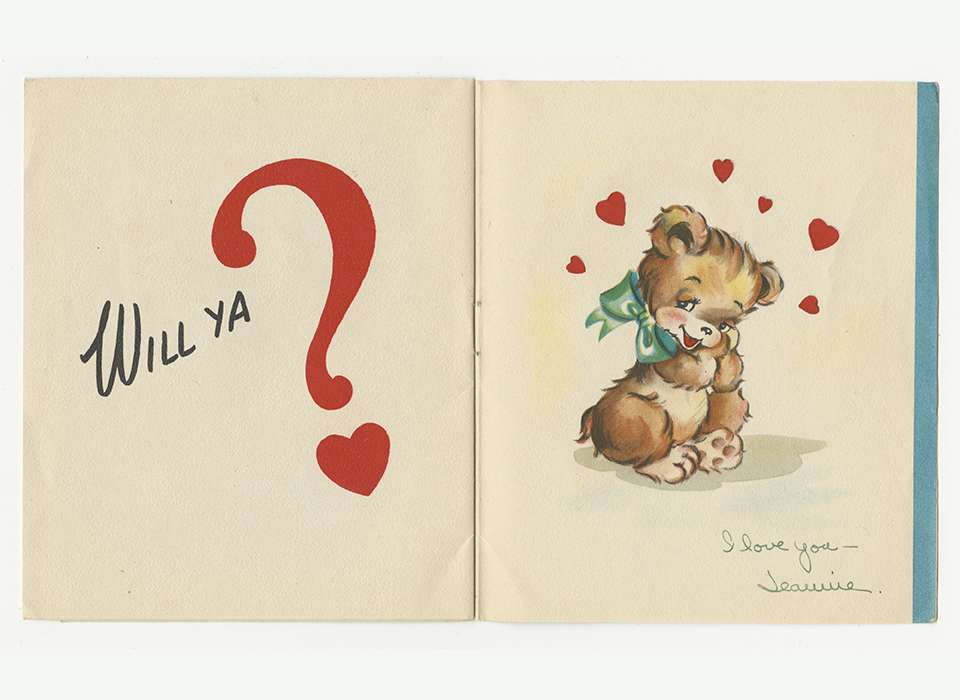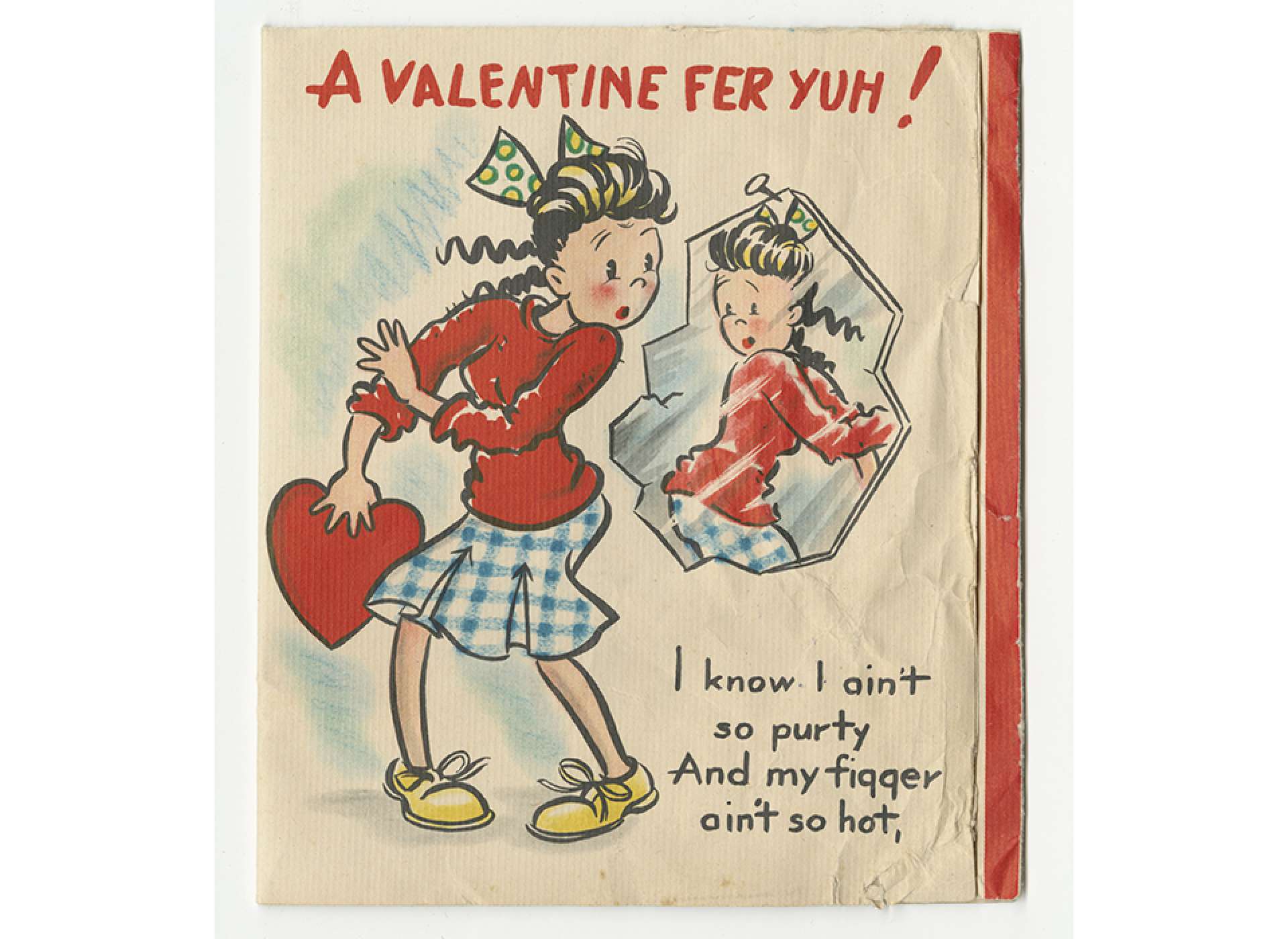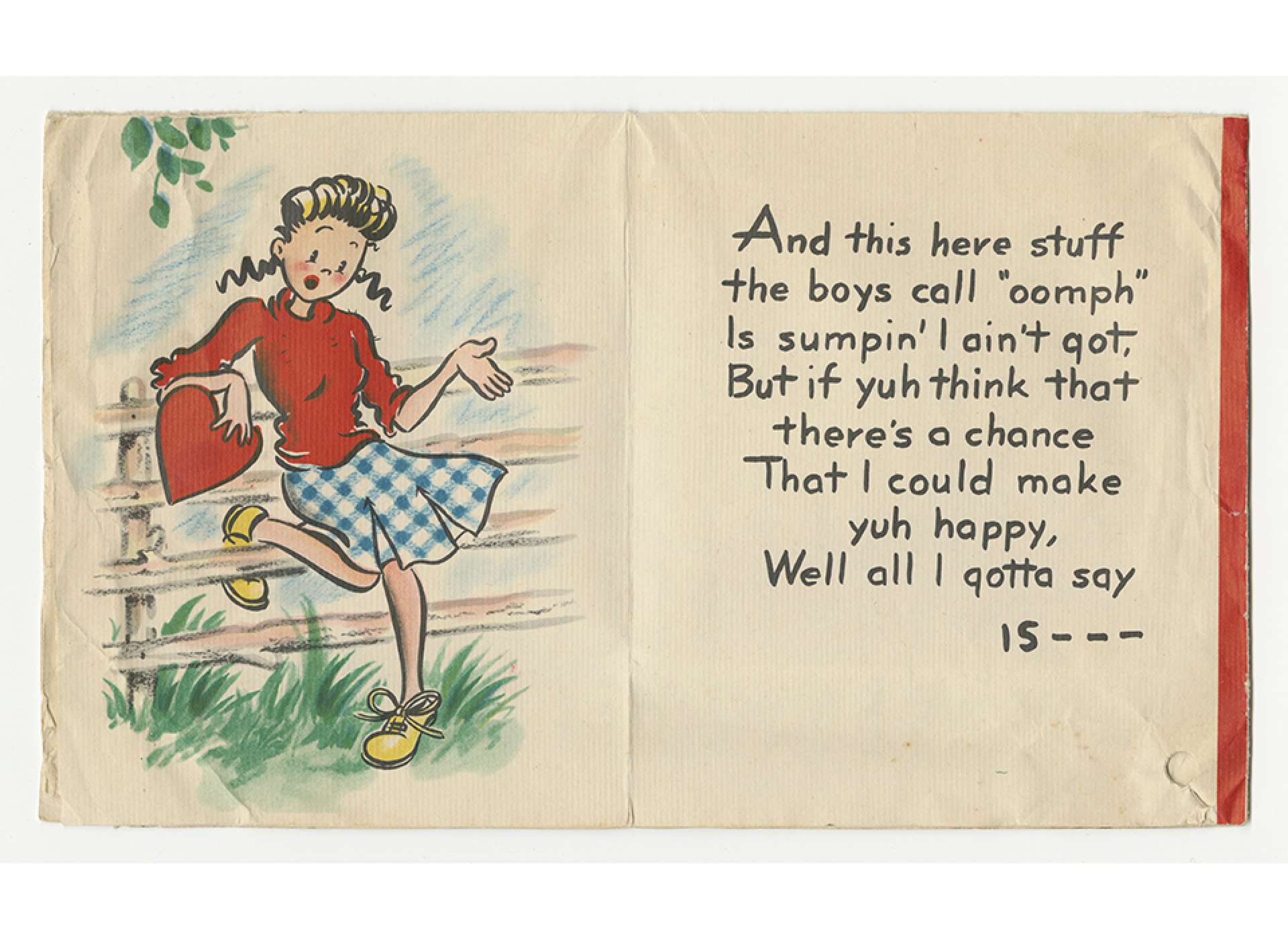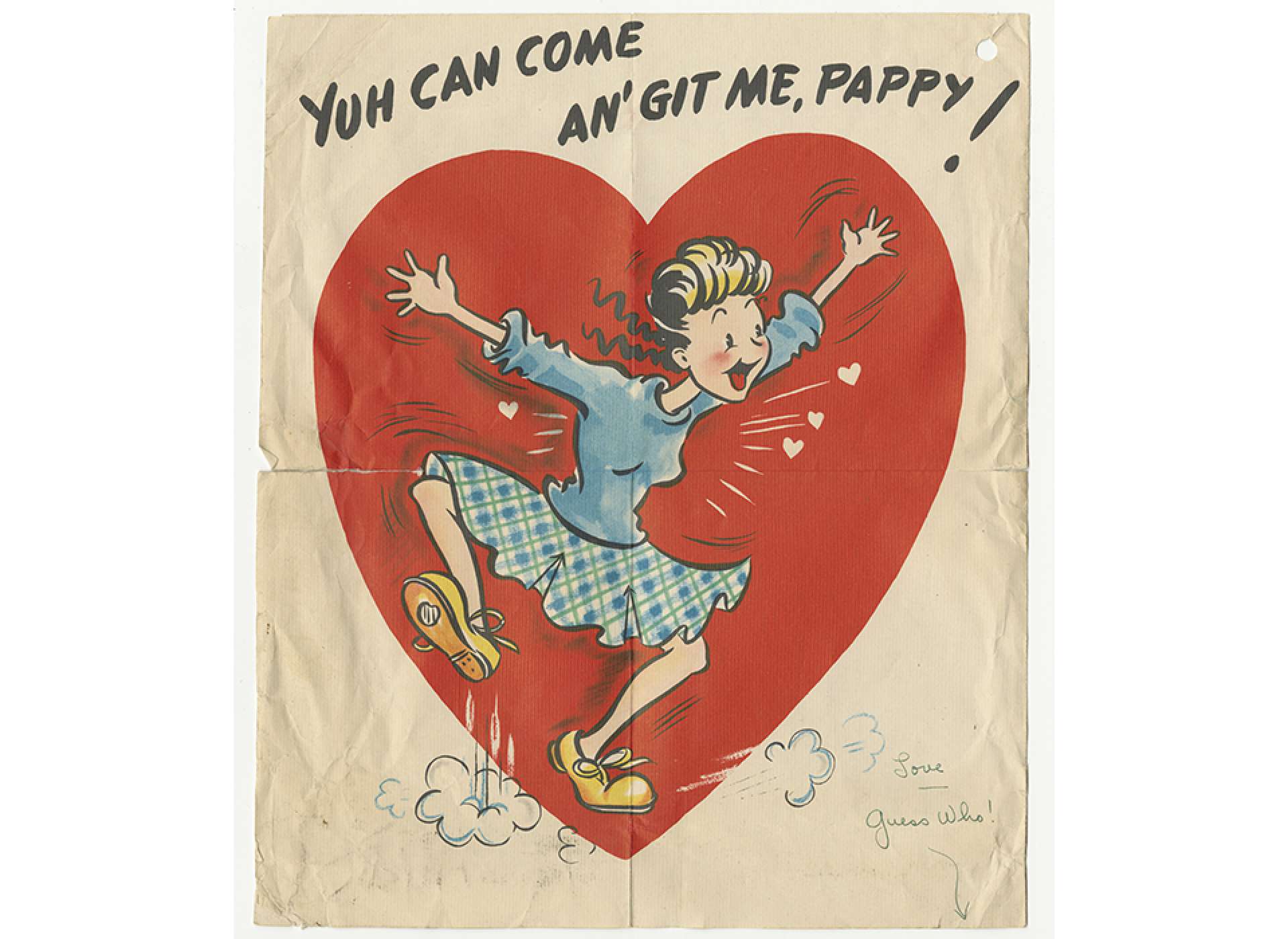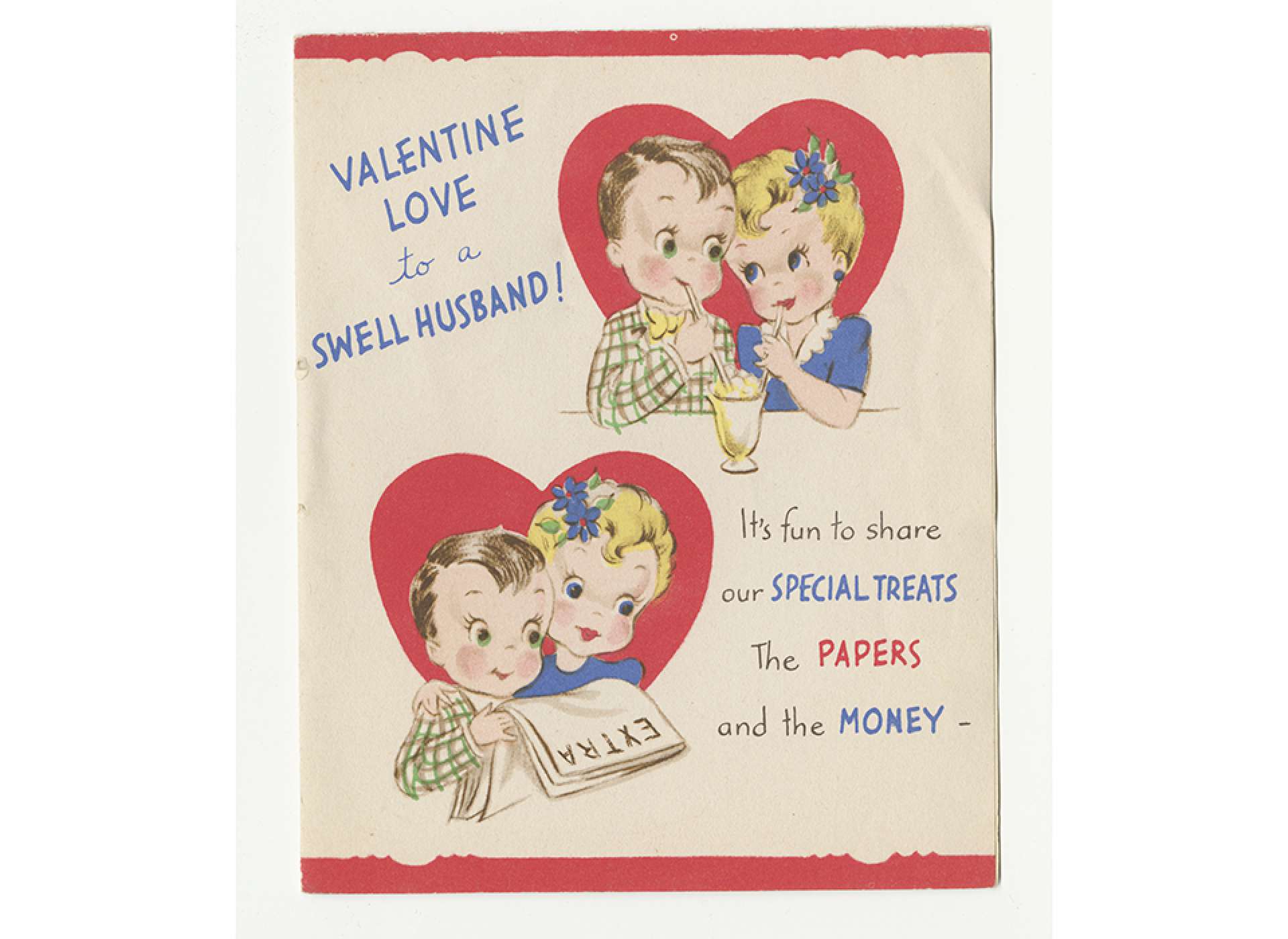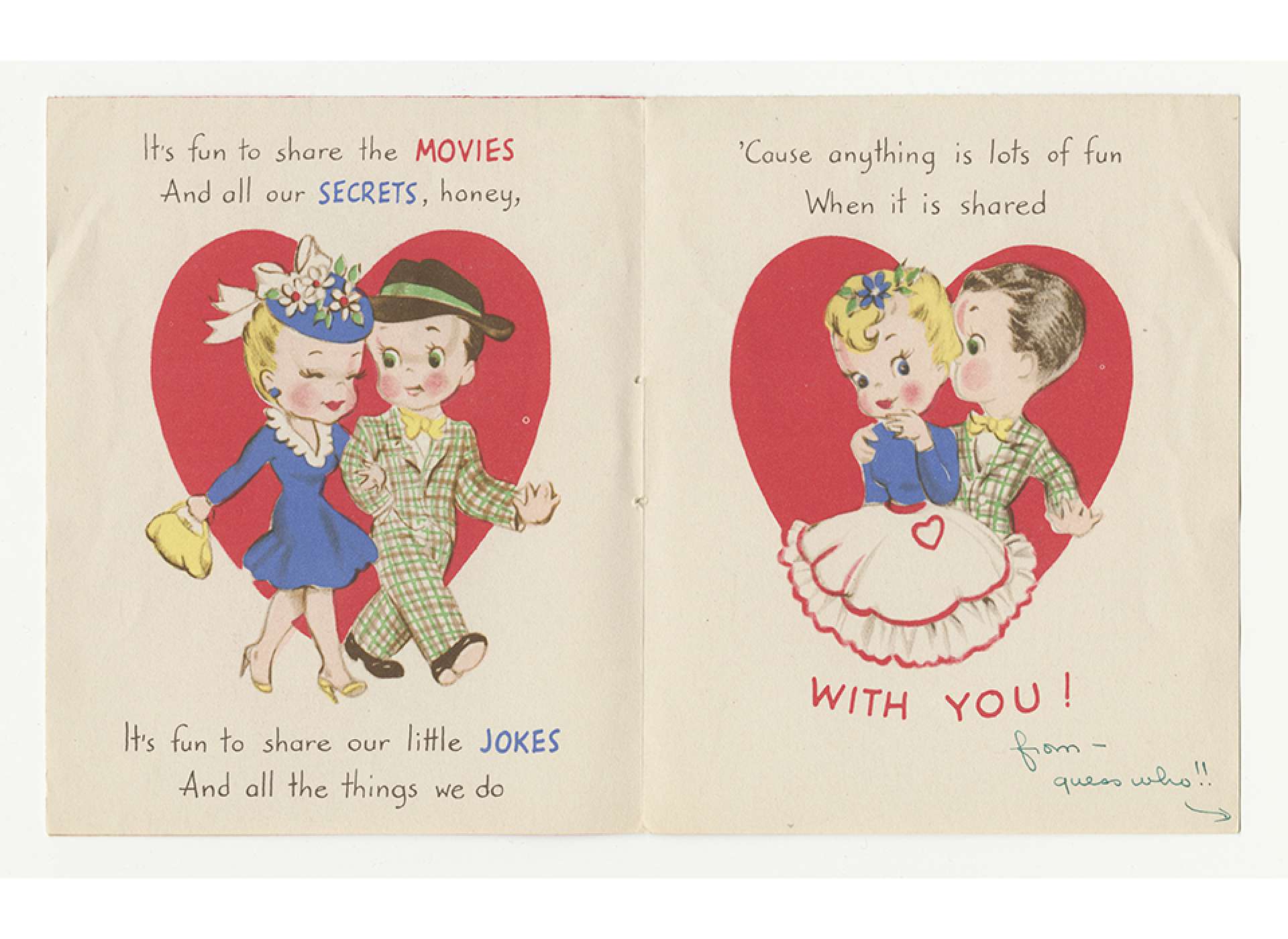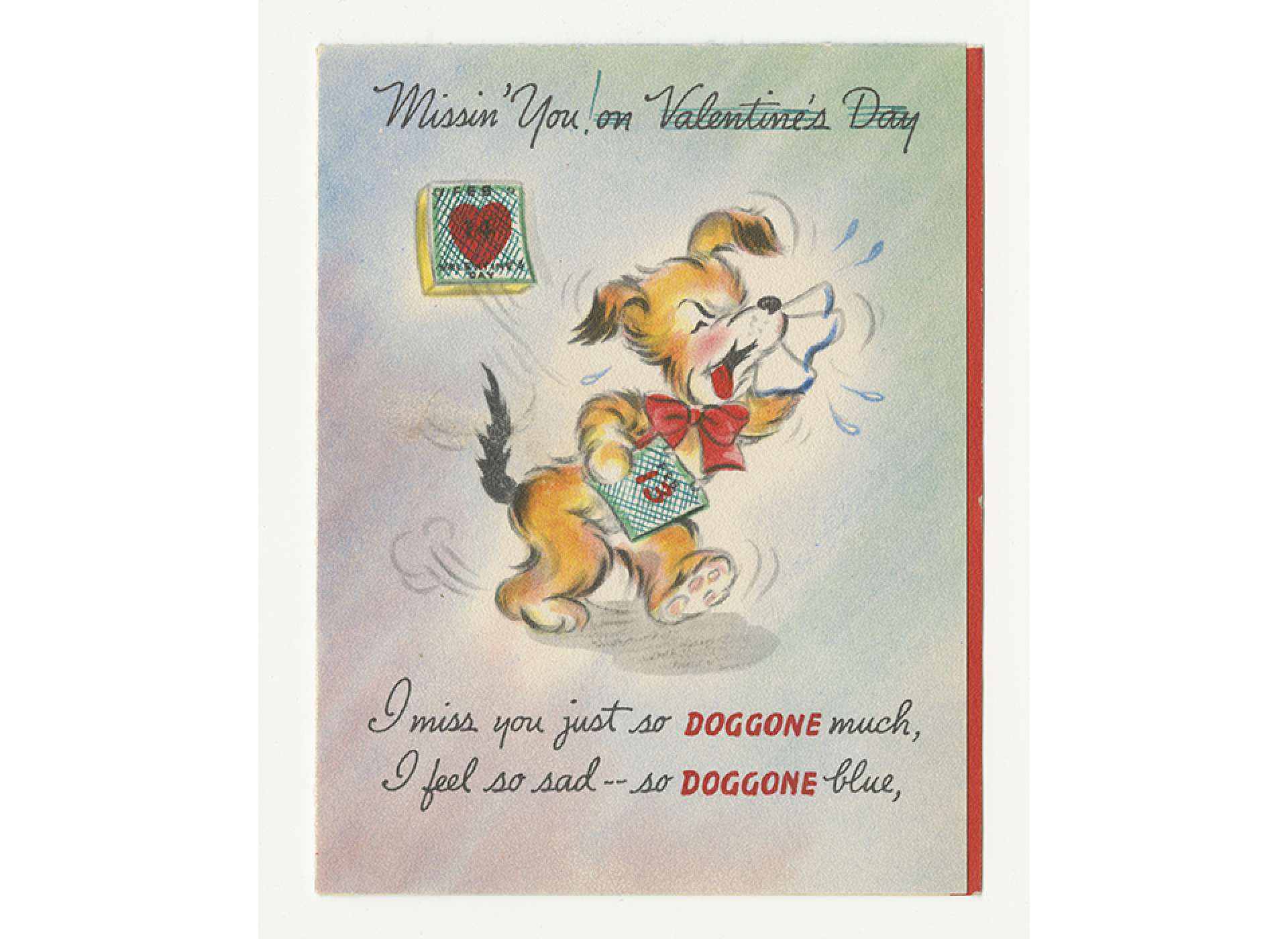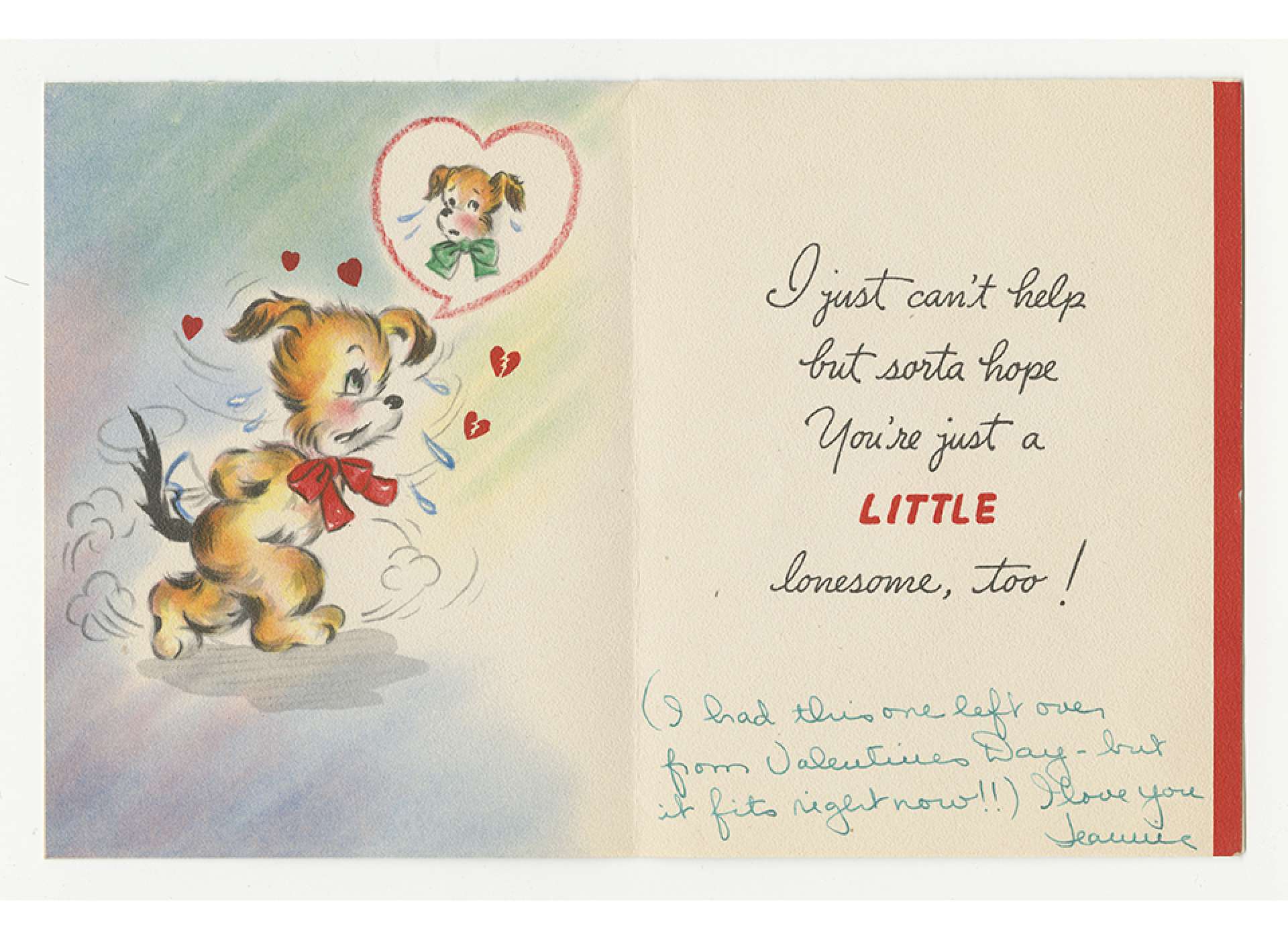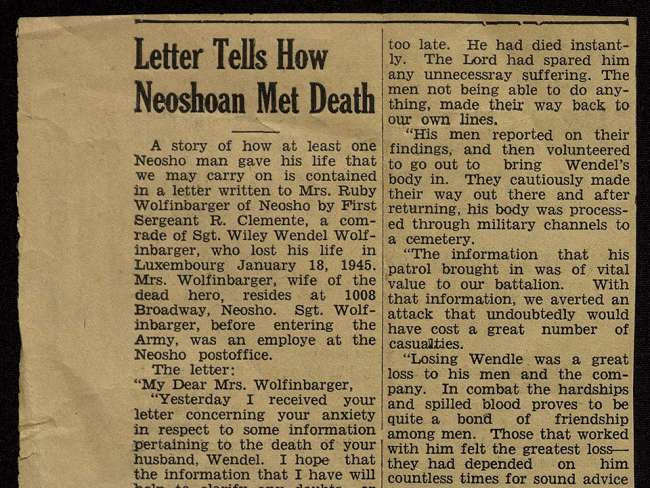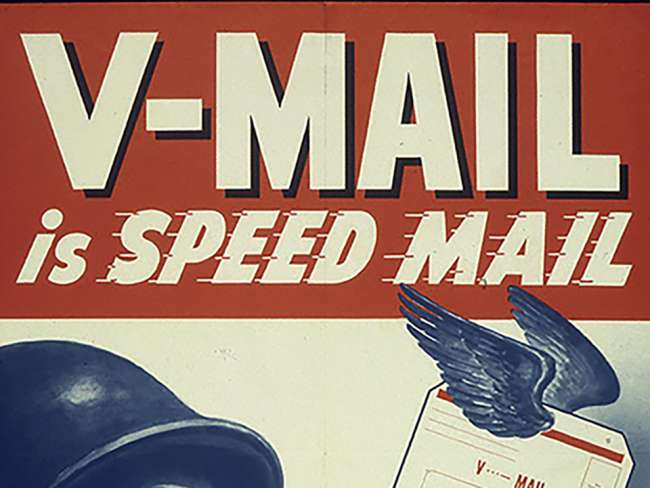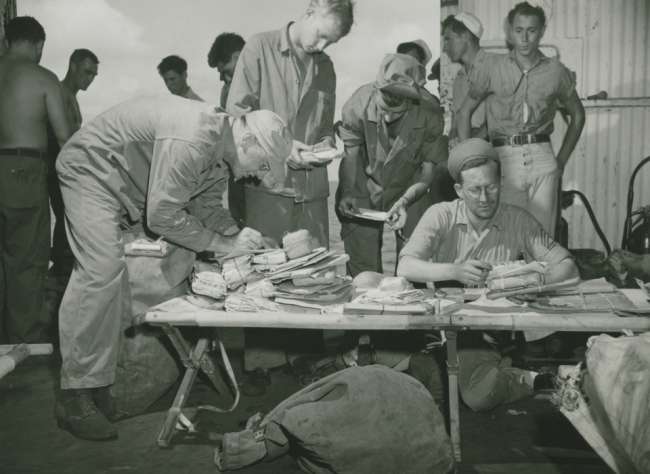During World War II, the simple act of sending a valentine assumed a tremendous significance. Servicemen fighting overseas wrestled with homesickness as they endured dreadful conditions and faced constant danger, while stateside sweethearts and family members agonized over the fate of loved ones in the Armed Forces. Correspondence dramatically boosted morale and composing letters eased anxieties both on the Home Front and abroad.
So, when Valentine’s Day arrived, partners, friends, and family felt more compelled than ever to deliver heartwarming sentiments of love and affection to their significant others, children, relatives, and pals. This was often in the form of mass-produced greeting cards with handwritten notes inside. A large number, specifically designed with military personnel and objectives in mind, featured patriotic color schemes and combat-related puns.
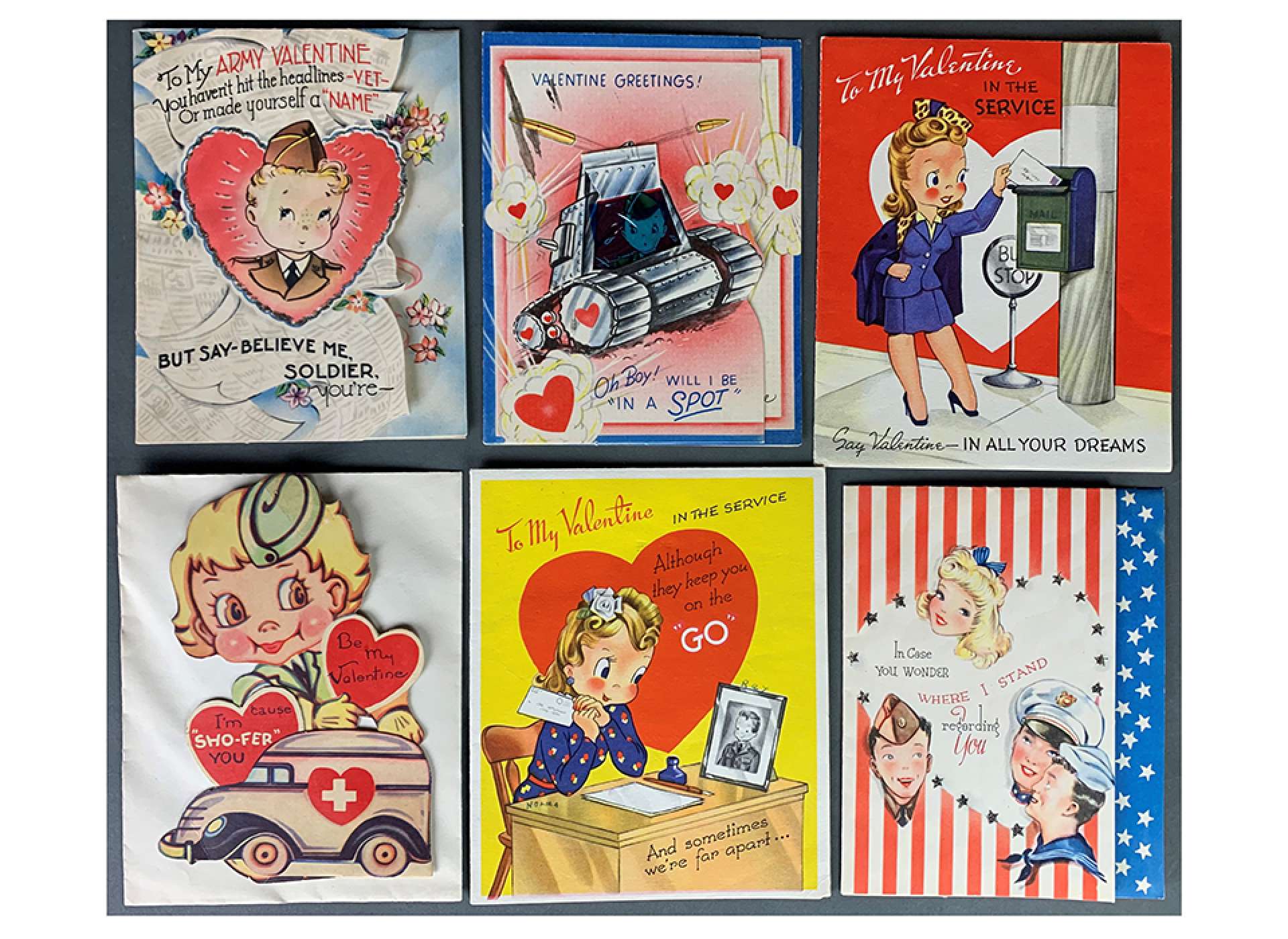
A varied collection of service-related valentines. The National WWII Museum, Gift of Pamela and Marshall Lacey, 2013.354.
The Museum possesses an extensive array of wartime Valentine’s Day letters. One particularly moving collection of correspondence highlights just how much lovers relied on cards and letters to maintain contact, provide solace and support, strengthen emotional bonds, and foster love. Hundreds of exchanges between a newlywed couple over the course of a single year tell the intimate story of their unrelenting passion, dreams and desires, fears and failings, and growth—both personal and shared.
A Train Cabin Crush
Richard Porritt Sr. and Jean Wadsten (“Dick” and “Jeannie” in their correspondence) met in June 1944 aboard a westbound train headed for San Francisco. Ensign Porritt, commissioned in September the year prior, had orders to report to the USS Tazewell (APA-209), while Jean accompanied her visiting sister and four year old niece on their return journey home to the West Coast. Neither anticipated falling in love.
Richard first saw Jean, alongside her niece, during a stopover in Chicago. He found her extraordinarily beautiful but presumed that she was married. Back in the compartment Richard shared with two friends, he told of the stunning woman he sighted on the platform, and they proposed investigating her marital status further. Family lore claims that the men flipped a coin to decide who would break the ice and, as fate would have it, Richard won the honors of approaching Jean at the next terminal.
Upon discovering that she was unwed and Janet her niece, the guys became regular guests in her cabin. Jean considered them an amusing and convivial bunch but especially enjoyed Richard’s company, sharing laughs and good conversation with him for the remainder of the journey.
The two formed an unlikely bond—Jean, part of a close-knit family and the product of strict Lutheran rearing, and Richard, an impetuous child of divorced parents who spoke coarsely and acted without constraint. Yet, despite their wildly different upbringings and personalities, the two fell fast in love.
A Summer Courtship
Whenever time permitted, Richard arranged dates across San Francisco. He and Jean dined and danced their way through the city, often stopping to amble about in local parks. With each departure, their fondness for each other grew stronger, and before the summer’s end, Richard knew he wanted to get married. He proposed in a movie theater shortly thereafter, and Jean responded with an emphatic “Yes!”
The bride and groom tied the knot in September 1944 and honeymooned briefly in San Francisco. They explored the metropolis and enjoyed the varied entertainment it afforded, passing their evenings in classy restaurants and the nights in stylish hotels. Before long, the USS Tazewell was officially commissioned and ordered to Seattle, Washington, to load men and supplies before departing for Hawaii to embark garrison troops and join a convoy bound for the Philippines. That meant an extended period of separation.
Love Letters at Sea
Writing letters was the only recourse the pair had for an imminent and painful parting. The correspondence started at the beginning of December 1944 and continued through to the following November.
Out at sea, Richard begged for letters, as many as Jean was willing to write. He explained,
“You see, darling, mail is a fellow’s whole life out here and it’s the greatest morale builder there is.”
Richard Porritt Sr.
Jean did her best to oblige. In one of her earliest letters right before Christmas, she informed Richard that—if her suspicions were correct—he could plan to be a father. Though his absence pained him, the news filled him with unbridled excitement. Jean also kept her husband apprised of family affairs and current events at home. In return, he told Jean what he could reveal of his adventures and detailed his efforts to cut back on gambling and pick up a Bible. Ironically, he even vowed to get rid of his “sailor’s mouth.”
Wartime Valentines
The Porritt’s routinely professed their love for one another, but Valentine’s Day was a special occasion to show affection in a purposeful and meaningful way. Apparently, Jean could not restrict her boundless love to a single card and, instead, articulated her feelings in a series of romantic and uplifting Valentine’s Day letters.
The first she sent was in January, well in advance of the holiday. Inside of an illustrated fold-out card, complete with a self-deprecating poem, she wrote in her characteristic, teal-toned ink a short phrase that would become a common feature in her letters: “Love—guess who!” Below she doodled an arrow as if to instruct, “Flip to reveal the answer.” On the reverse, she wrote of how desperately she yearned for Richard’s return—as well as his touch—and how eagerly she awaited feeling the baby’s first kicks.
Less than a week passed before she dispatched two additional valentines. Even if Jean was exhausted and lacked the requisite energy to “write a real letter,” she could always depend on a greeting card to convey her emotions. In her opinion, a card could communicate “an awful lot of sentiment for a quarter.”
-

Jean Porritt’s first valentine to her husband. The National WWII Museum, Gift of the Children of Richard H. and Jean W. Porritt, 2014.442.025.
-

Jean Porritt’s first valentine to her husband. The National WWII Museum, Gift of the Children of Richard H. and Jean W. Porritt, 2014.442.025.
-

Jean Porritt’s first valentine to her husband. The National WWII Museum, Gift of the Children of Richard H. and Jean W. Porritt, 2014.442.025.
-

The second in a succession of valentines that Richard Porritt received while in service. The National WWII Museum, Gift of the Children of Richard H. and Jean W. Porritt, 2014.442.027.
-

The second in a succession of valentines that Richard Porritt received while in service. The National WWII Museum, Gift of the Children of Richard H. and Jean W. Porritt, 2014.442.027.
In early February, Jean shipped off what she referred to as Richard’s “real valentine,” her portrait to keep by his bedside to make his solitude a little more bearable. Then, just two days before Valentine’s Day—likely lonelier and more lovesick than usual—she penned one of her more intimate letters. She reminisced about the passionate nights they spent together before the exigencies of war forced them apart. On the final page she left an impression of her kiss in red lipstick and spritzed the stationary with the perfume she wore during the wedding and honeymoon, hoping the scent would evoke pleasant memories.
The final valentine Jean sent a month after the holiday passed. She conveniently had an unused card and appreciated its sentiment, so she simply struck through a few words to transform it into a general-purpose greeting card. Richard thoroughly enjoyed all of his letters, writing to Jean that he loved each one and read them many times. That he saved all her cards and letters is a testament to their significance during his service.
-

A modified and repurposed valentine Jean sent to tell Richard she missed him. The National WWII Museum, Gift of the Children of Richard H. and Jean W. Porritt, 2014.442.056
-

A modified and repurposed valentine Jean sent to tell Richard she missed him. The National WWII Museum, Gift of the Children of Richard H. and Jean W. Porritt, 2014.442.056
Looking to the Future
The end to hostilities could not come soon enough. Richard worried the war might steal the best years of his life and regularly ruminated about what the future held. He thought briefly about turning his naval stint into a career but detested the thought of any more separations. He also contemplated becoming a teacher but could not see himself as “the professor type.” As to where they would settle, he envisioned living near family along the North Atlantic seaboard or somewhere in California. Jean, on the other hand, did not care about the details—so long as they were together.
As the letters make clear, the one constant in their joint vision of the future was the plan to have a large family. In that regard, they were quite successful. Jean delivered their first child in August 1945, while Richard (then a Lieutenant Junior Grade) was still in the Pacific. They ultimately had four more children, though one sadly died in infancy.
Richard and Jean Porritt were happily married for 64 years and never missed a chance to convey their devotion to one another. The life they shared together, and the letters that kept them close when they were most distant, left an enduring legacy of the power of unconditional love and the importance of expressing it.
Chase Tomlin
Chase Tomlin is an Associate Curator at The National WWII Museum.
Cite this article:
MLA Citation:
APA Citation:
Chicago Style Citation:
